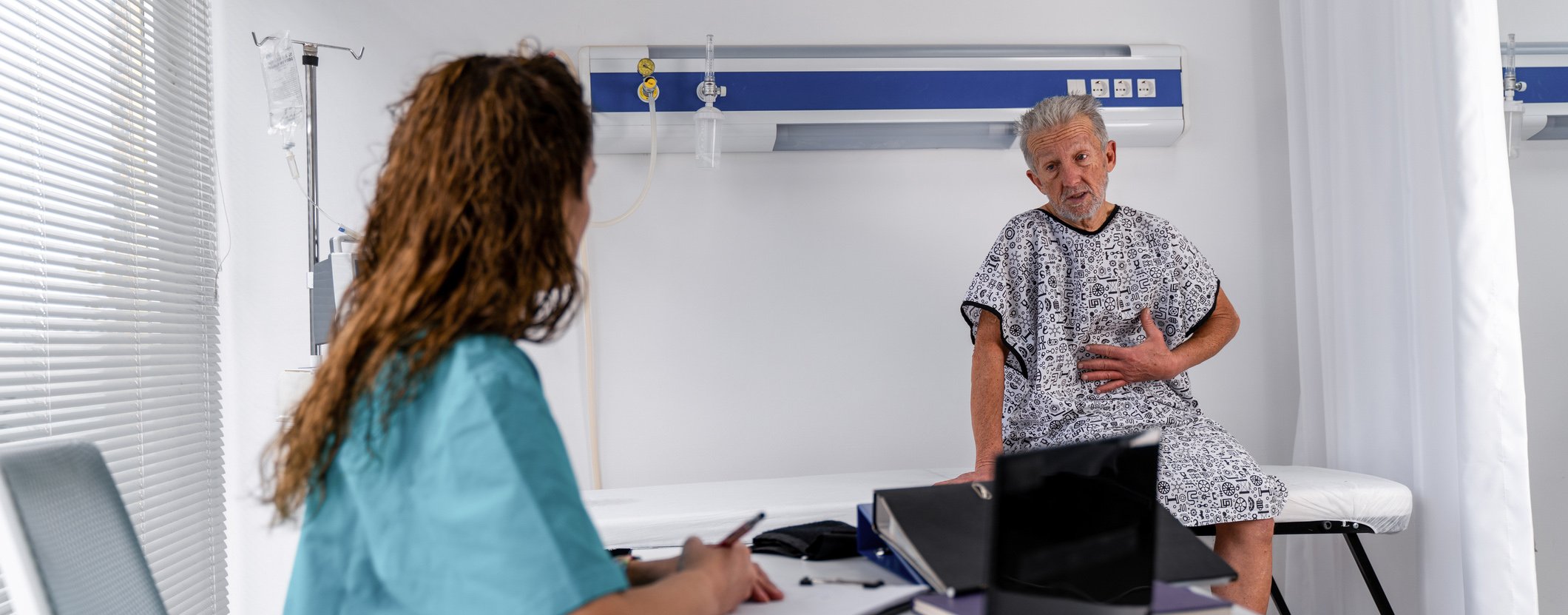A 53-year-old man has been suffering from slowly increasing respiratory symptoms such as cough, chest tightness to shortness of breath for several years. While they initially manifested themselves only after heavy physical exertion, they now occur even after minor exertion. In addition, there is increasing general fatigue and tiredness. His doctors get to the bottom of the mystery by asking about private hobbies: the man is a pigeon breeder.
On medical examination of the lungs, crackle rales and fibrosis squeaks are heard; on high-resolution lung CT, the radiologist describes reticulonodular infiltrate, signs of fibrosis and emphysema, and bronchiectasis. Spirometry reveals mainly signs of a restrictive disorder of ventilation with decreased VCIN, transfer capacity T-CO is moderately decreased at 55%. The patient is found to have lymphocytosis of 65% with a CD4/CD8 quotient of 2.3, pigeon protein-specific IgG (serum, feathers, feces) is measured at 71 mg/l. A prick test with pigeon feathers is positive. Practitioners diagnose chronic fibrosing exogenous allergic alveolitis (EAA) due to pigeon allergens, called pigeon breeder’s lung.
The patient must then unfortunately give up his pigeon breeding, he is advised to have former nest rooms dismantled and disposed of or otherwise thoroughly and professionally cleaned, write Prof. Dr. Axel Trautmann, University Hospital Würzburg (D), and Prof. Dr. Jörg Kleine-Tebbe, Allergy and Asthma Center Westend, Berlin (D) [1]. Therapeutically, an oral glucocorticoid is a longer-term option for the pigeon fancier, possibly combined with a steroid-sparing immunosuppressant. The efficacy of antifibrotic treatment with nintedanib or pirfenidone for chronic fibrotic EAA-unlike idiopathic pulmonary fibrosis-has not yet been supported by trial data, he said.
Symptomatology and diagnosis
Because the disease was initially observed only in association with agricultural activity, EAA was initially referred to as farmer’s lung. In fact, farmers are still a risk group today (prevalence 2.5% vs. general population 0.003%), but people who work in fully air-conditioned rooms (humidifier lung) or as described bird owners (bird owner lung) are also more affected.
EAA can be caused by an IgG (type III) and T lymphocyte (type IV) mediated immune response to components of bacteria or molds, organic dust (animal or plant proteins), or even certain reactive chemicals. The clinical spectrum of EAA includes both an acute flu-like illness and chronic COPD-like symptoms that are the result of a granulomatous and fibrotic inflammatory response in the lungs.
In comparison, the acute phase of EAA occurs much less frequently; most patients suffer from a chronic form of progression (Tab. 1). The problem is that if the diagnosis is made early and the causative allergen is strictly avoided, the prognosis of EAA is good to very good – but if it is chronic (which can be associated with progressive pulmonary fibrosis), the prognosis is much worse. Chronic fibrotic EAA tends to worsen insidiously with COPD-like symptoms, the authors write. In CT, for example, reticular pattern and honeycomb structure catch the eye.

There is no single proving finding for EAA, especially differentiating chronic EAA from a different form of pulmonary fibrosis is often difficult. The most important component of the diagnosis is therefore the specific question about the occupational activity and certain living conditions that could indicate a typical allergen source: including agriculture, handling animals, printing industry with air humidification, food processing, wood processing, housing situation (air conditioning, mold infestation). This usually gives rise to an initial suspicion. CT lung, pulmonary function with diffusion capacity, and bronchoalveolar lavage (sensitivity >90%) are considered additional building blocks for diagnosis.
|
New release In 2022, the 4th edition of the volume “Allergologie in Klinik und Praxis. Allergene – Diagnostik – Therapie” was published by Thieme-Verlag. In 41 chapters, overviews are first given (“The Immune System”, “Determination of IgE in Serum”, before the authors present individual clinical pictures, from asthma to urticaria and food/contact allergies to drug and vaccine reactions. After an introduction, the individual chapters are subdivided into sections on symptoms, diagnostics and treatment; case histories provide insights into everyday practice. Trautmann A, Kleine-Tebbe J, eds: Allergologie in Klinik und Praxis. 4th, completely revised edition. Stuttgart: Thieme; 2022. |
Therapy
The most important and effective measure for the treatment of EAA is to edit the exposure of the respiratory air to the allergen or, ideally, to avoid the allergen altogether. According to the authors, empirical experience with glucocorticoid treatment comes from the two most common forms, farmer’s lung and pigeon breeder’s lung; however, controlled studies are not available.
Drug treatment depends on the clinical form of EAA: for the acute form, an immunomodulatory approach is the first choice; for chronic fibrotic EAA, antifibrotic therapy is increasingly coming to the fore.
- Acute inflammatory EAA: 40-60 mg PE*/day for 1-2 weeks, slowly lowering the dose over another 4-6 weeks.
- Chronic fibrotic EAA: 40-60 mg pa*/day for 4 weeks, slowly lowering dose over 3 months, maintenance dose (usually 10-30 mg/day) for another 2 months. If follow-up after 6 months suggests improvement, treatment can be continued at approximately 10 mg/day, possibly combined with a classical immunosuppressant (azathioprine, mycophenolate)
In advanced pulmonary fibrosis with hypoxemia, physicians advise permanent oxygenation; lung transplantation remains as the last resort.
* Prednisone/Prednisolone Equivalent
Literature:
- Trautmann A, Kleine-Tebbe J: Exogenous allergic alveolitis. In: Trautmann A, Kleine-Tebbe J, eds: Allergologie in Klinik und Praxis. 4th, completely revised edition. Stuttgart: Thieme; 2022; doi: 10.1055/b000000469.
InFo PNEUMOLOGY & ALLERGOLOGY 2022; 4(3): 28-29.











